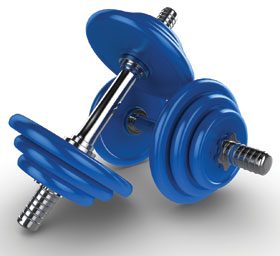Strength training movements: Strength training does not mean joining the muscle guys at Venice Beach.
Simple strength exercises with your body weight can be beneficial. The general recommendation is to do eight to 10 strength-training exercises with 10 to 15 repetitions of each exercise, two to three times per week. If you don't have weights, you can use your body weight. Simply do squats against the wall, or do a push-up against the edge of a table. Remember, the key is to start off small and work your way up.
 When I ask patients why they aren't doing any strength training, a common response is that they can't lift heavy weights or that their body can't handle the physical stress. Unfortunately, the constant images of Hulk-like individuals working out has contributed to a lot of misinformation out there. Many people believe they need to lift heavy weights to see some changes in their muscles. Research is actually showing that high-repetition exercises with lower-weight loads can be as good, if not better, than heavy lifting. Therefore, don't rule out weight training because you can't handle heavy weights. A recent study from McMaster University in Hamilton, Ontario, Canada, revealed that an exercise program using a low weight load, but high volume of exercise, produced better results than lifting heavier weights. The message: If you want to increase muscle strength and tone, and get the benefits associated with strength training, simply start out with lighter weights and do as many reps as you can until you can't do any more.
When I ask patients why they aren't doing any strength training, a common response is that they can't lift heavy weights or that their body can't handle the physical stress. Unfortunately, the constant images of Hulk-like individuals working out has contributed to a lot of misinformation out there. Many people believe they need to lift heavy weights to see some changes in their muscles. Research is actually showing that high-repetition exercises with lower-weight loads can be as good, if not better, than heavy lifting. Therefore, don't rule out weight training because you can't handle heavy weights. A recent study from McMaster University in Hamilton, Ontario, Canada, revealed that an exercise program using a low weight load, but high volume of exercise, produced better results than lifting heavier weights. The message: If you want to increase muscle strength and tone, and get the benefits associated with strength training, simply start out with lighter weights and do as many reps as you can until you can't do any more.
Get Up and Get Moving
I know I'm repeating myself here, but that's because it's so important (and because so many people don't seem to get it these days): When it comes to movement, any type of movement can be beneficial and is definitely better than not moving at all; after all, research suggests being sedentary can be as detrimental as smoking over time. The goal is not to run a marathon (unless that's your goal), but rather to introduce new ways to get up and move every day. The health benefits are just too great to overlook the power of movement. If you "get up and go" regularly, keep up the good work! It's doing you and your body a world of good. If you need to move more (or at all), what are you waiting for? Take the first steps toward better health and a better you today; you won't regret it.
Enjoy the Benefits of MOVEMENT
Cardiovascular exercise and strength training are two important ways to get your body moving and reap the important health benefits, including but certainly not limited to:
 Cardio Movements:
Cardio Movements:
- Helps maintain healthy weight
- Reduces blood pressure
- Reduces risk of diabetes
- Increases endurance and energy
- Helps cope with stress
- Helps maintain mental fitness
Strength Training Movements:
- Fewer injuries due to stronger muscles
- Tones your muscles
- Increases energy
- Strengthens bones and decreases
- Risk of osteoporosis
- Decreases resting blood pressure
- Decreases arthritis pain
Jasper Sidhu, DC, graduated from Canadian Memorial Chiropractic College in 1994 and opened the Downtown Injury Rehab Centre in Windsor, Ontario, incorporating vibration training into the rehabilitation part of his practice. He is vice president of clinical services for WAVE Manufacturing (www.wavexercise.com).

